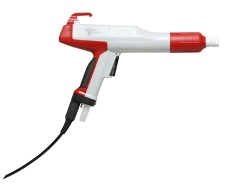Content Menu
● Understanding Electrostatic Spray Technology
>> How Electrostatic Spray Guns Work
>> Benefits of Using Manual Electrostatic Spray Guns
● Key Factors to Consider Before Buying
>> 1. Application Needs
>> 2. Compatibility with Coatings
>> 3. Transfer Efficiency and Atomization Quality
>> 4. Ergonomics and Ease of Use
>> 5. Maintenance and Durability
>> 6. Cost of Ownership
● Popular Brands and Models
● Setup and Operation Tips
>> Preparing for Use
>> Safety Precautions
>> Adjusting Settings
● Common Challenges and Solutions
>> 1. Poor Transfer Efficiency
>> 2. Uneven Coating
>> 3. Clogging
● Conclusion
>> Frequently Asked Questions
When it comes to applying coatings, whether for industrial purposes or DIY projects, a manual electrostatic spray gun can be a game-changer. These tools offer precision, efficiency, and a high-quality finish that traditional spray methods often cannot match. However, before making a purchase, there are several factors to consider to ensure you choose the right model for your needs. This article will guide you through the essential aspects of manual electrostatic spray guns, helping you make an informed decision.

Understanding Electrostatic Spray Technology
How Electrostatic Spray Guns Work
Electrostatic spray guns utilize an electrostatic charge to attract paint particles to the surface being coated. This technology enhances transfer efficiency, meaning more paint adheres to the object rather than being lost to overspray. The basic principle involves charging the paint particles as they exit the gun, which are then attracted to the grounded surface. This results in a more uniform coating and reduced waste.
Benefits of Using Manual Electrostatic Spray Guns
1. High Transfer Efficiency: Manual electrostatic spray guns can achieve transfer efficiencies of up to 95%, significantly reducing paint waste.
2. Superior Finish Quality: The electrostatic charge helps create a smooth, even finish, which is particularly important for aesthetic applications.
3. Versatility: These guns can be used on various surfaces, including metals, plastics, and wood, making them suitable for multiple applications.
4. Reduced Cleanup: With less overspray, there is less mess to clean up after the job is done.
Key Factors to Consider Before Buying
1. Application Needs
Before purchasing a manual electrostatic spray gun, consider what you will be using it for. Different applications may require different features. For instance, if you are painting large industrial parts, you may need a gun with a higher output and larger fluid delivery capacity. Conversely, for smaller projects, a more compact model may suffice.
2. Compatibility with Coatings
Not all electrostatic spray guns are compatible with every type of coating. It's crucial to ensure that the gun you choose can handle the specific materials you plan to use, whether they are solvent-based, water-based, or powder coatings. Check the manufacturer's specifications for compatibility.
3. Transfer Efficiency and Atomization Quality
When evaluating different models, pay attention to their transfer efficiency and atomization quality. A gun that provides fine atomization will deliver a more even coat, while high transfer efficiency will minimize waste. Look for models that offer adjustable settings to optimize these factors based on your specific needs.
4. Ergonomics and Ease of Use
Since you may be using the spray gun for extended periods, comfort is essential. Look for a model that is lightweight and well-balanced, with ergonomic grips that reduce fatigue. Additionally, consider how easy it is to adjust settings and clean the gun after use.
5. Maintenance and Durability
Manual electrostatic spray guns require regular maintenance to ensure optimal performance. Check the availability of replacement parts and the ease of maintenance. Guns made from high-quality materials will withstand the rigors of daily use better than cheaper alternatives.
6. Cost of Ownership
While the initial purchase price is important, consider the total cost of ownership, which includes maintenance, replacement parts, and the cost of coatings. A more expensive gun may offer better efficiency and durability, leading to lower overall costs in the long run.
Popular Brands and Models
When it comes to manual electrostatic spray guns, several brands are known for their quality and reliability. Some of the most popular include:
- Graco: Known for their robust construction and high transfer efficiency, Graco guns are a favorite among professionals.
- Nordson: Offers a range of models suitable for various applications, with a focus on precision and ease of use.
- Wagner: Provides affordable options that still deliver good performance, making them ideal for DIY enthusiasts.
- Binks: Known for their durability and high-quality finishes, Binks guns are often used in industrial settings.
Setup and Operation Tips
Preparing for Use
Before using your manual electrostatic spray gun, ensure that you have all necessary equipment, including a suitable air compressor, pressure pots, and any additional accessories required for your specific application. Proper setup is crucial for achieving the best results.
Safety Precautions
Using an electrostatic spray gun involves certain risks, including exposure to harmful chemicals and the potential for static electricity hazards. Always wear appropriate personal protective equipment (PPE), such as gloves, goggles, and respirators. Ensure that your workspace is well-ventilated and free from flammable materials.
Adjusting Settings
Take the time to adjust the settings on your spray gun according to the material you are using and the desired finish. Experiment with different flow rates and spray patterns to find the optimal configuration for your project.
Common Challenges and Solutions
1. Poor Transfer Efficiency
If you notice that a lot of paint is being wasted, check the distance between the gun and the surface. The ideal distance is typically between 6 to 12 inches. Additionally, ensure that the electrostatic charge is functioning correctly.
2. Uneven Coating
Uneven application can result from improper atomization or incorrect settings. Make sure to clean the nozzle regularly and adjust the fluid delivery settings as needed.
3. Clogging
Clogging can occur if the paint is too thick or if debris enters the system. Always strain your paint before use and clean the gun thoroughly after each session.
Conclusion
Investing in a manual electrostatic spray gun can significantly enhance your coating projects, providing superior finishes and reducing waste. By considering your specific needs, the compatibility of coatings, and the features of different models, you can make an informed decision that will pay off in the long run. Remember to prioritize ergonomics, maintenance, and total cost of ownership to ensure you choose the best tool for your applications.

Frequently Asked Questions
1. What is the main advantage of using an electrostatic spray gun?
- The main advantage is high transfer efficiency, which reduces paint waste and provides a superior finish.
2. Can I use any type of paint with an electrostatic spray gun?
- No, it's essential to ensure that the paint is compatible with electrostatic application. Check the manufacturer's specifications.
3. How often should I clean my electrostatic spray gun?
- It's recommended to clean the gun after each use to prevent clogging and maintain performance.
4. What safety gear should I wear when using a spray gun?
- Always wear gloves, goggles, and a respirator to protect against harmful chemicals and static electricity hazards.
5. How do I know if my spray gun is set up correctly?
- Proper setup includes checking the distance from the surface, ensuring the electrostatic charge is functioning, and adjusting the settings for optimal performance.
Hot Tags: China, Global, OEM, private label, manufacturers, factory, suppliers, manufacturing company










































 .
. 